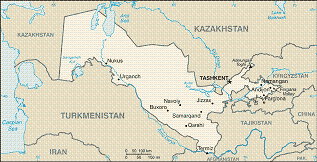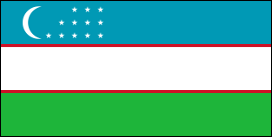
Uzbekistan (Uzbek: Oʻzbekiston), officially known as the Republic of Uzbekistan (Uzbek: Oʻzbekiston Respublikasi) is a Central Asian country, formerly part of the Soviet Union. It shares borders with Kazakhstan to the west and to the north, Kyrgyzstan and Tajikistan to the east, and Afghanistan and Turkmenistan to the south, being the only one to border all five. It's also one of the only two countries in the world, alongside Liechtenstein, to be doubly-landlocked (i.e. you need to cross two states to find sea).
With 33 million people living in the country, Uzbekistan is by far the most populous Central Asian country. It is about 60% more populous than Kyrgyzstan, Tajikistan, and Turkmenistan combined, and Kazakhstan has about 55% of the population living in six times as much area. There's a reason for that. When the country's border was set up by the Soviets, it was lucky enough to receive the most fertile, most desirable, and thus most populous parts of the region. The fertile lowland Bactria occupies the south; the even more fertile Sogdia, home of the capital Tashkent, large cities Samarkand and Bukhara, and mineral-rich Fergana Valley occupies the center and the eastern panhandle; and although the barren Kyzylkum desert mainly comprises the west, there is a large oasis south of the Aral Sea, known to historians as the Khwarezm region. There is not too much barren steppe (Kazakhstan), desertnote (Turkmenistan), or mountains (Kyrgyzstan and Tajikistan). All those parts were also the most historically significant, being the heart of the land route of Silk Road, an old trade network that enabled contact between Asia and Europe back when all you had were horses and caravans. Plus, it is located wholly in Transoxiana, a region in between the Amu Darya (Oxus) and Syr Darya (Jaxartes) rivers.
Before the late 1st millennium BCE, Transoxiana was mainly inhabited by Eastern Iranian confederations, both nomadic and settled. In the 6th century BCE, The Achaemenid Empire conquered the region, but with much resistance; Herodotus famously recorded that Cyrus the Great was killed while fighting against the Massagetae under Queen Tomyris, who in some tales beheaded and drowned his head into a vessel of blood. Later, it too fell alongside the Achaemenids to Alexander and his Macedonian army. Hellenistic domination continued until the 1st century CE, when power was wrestled by the nomads, this time under the various Indo-European tribes expelled from Xinjiang by the Xiongnu, including the Yuezhi and the Hephthalites. The Persians also made their move again under the Sassanids, but this time they were challenged by the Turks, who had formed a huge nomadic empire in Inner Asia known as the Turkic Khaganate. Slowly, Transoxiana shifted from being Eastern Iranian-speaking to Persian-speaking (in the south) and Turkic-speaking (the rest).
In the 8th century, Transoxiana was conquered by the Umayyad Caliphate under Qutayba ibn Muslim, but again with stiff resistance from the Turks. They also had to face Tang China, who prevented them from crossing the Tian Shan. The population gradually embraced Islam, especially once the Abbasid caliphate overthrew Marwan II and established a more egalitarian society. A century after conquest, Transoxiana broke away from the caliphate and formed the Samanids, a dynasty of Persian origin. They were succeeded by the Turkic Kara-Khanid Khanate, one of the earliest Muslim Turkic dynasties (they converted to Islam halfway through their rule). The Kara-Khanids, being of Karluk extraction, was significant in tracing the also Karluk Uzbeks' ancient lineage in the land. The Qara Khitai, founded by Buddhist Khitans expelled by the Jurchens from North China, and the Khwarezmians followed them thereafter. By this time, Sogdia was one of the wealthiest regions in the world and the cities of Bukhara and especially Samarkand became centers of Islamic learning. Ever heard of Avicenna? The famous physician was born in Bukhara.
Their glory came to an abrupt end when the Mongols invaded in the 13th century and basically reduced Transoxiana to rubble. The Chagatai Khanate emerged from the Mongol Empire but was conquered shortly thereafter by the most important person to hail from Transoxiana: Timur the Lame, a Turko-Persian who had the ambition to restore the Mongol Empire. He embarked on a conquest of Central Asia, the Iranian Plateau, and the Middle East in the 14th century and encouraged/forced many artisans and scholars to come to Samarkand. Like his inspiration's dominion, Timur's empire fractured not long after his death. Still, Central Asians, especially Uzbeks, regard him as a national hero, credited for rebuilding Central Asia after the Mongol devastation. In the 16th century, Transoxiana was ruled by three principal khanates: Kokand in the Fergana valley, Bukhara in the Sogdian heartland, and Khiva in Khwarezm. Tsarist Russia invaded in the 19th century, though they were content enough to turn Bukhara and Khiva into protectorates.
The Russian Revolution made both independent, but they were quickly overrun by communists and turned into Soviet satellites. Despite some attempts by the Basmachi religious movement triggered as a reaction to conscription during World War I, the Russians ultimately regained control. The Soviet Union's reorganization of their Central Asian territories abolished the remaining khanates in 1925 and absorbed them into the newly created Uzbek Soviet Socialist Republic, which itself was made by carving bits and pieces from the former Turkestan and Kirghiznote Autonomous Soviet Socialist Republics (ASSR). Autonomy was given in 1932 to the Karakalpak Oblast due to its majority Karakalpak population, turning them into an ASSR within the Uzbek SSR. This decentralization is still recognized today as the self-ruled Republic of Karakalpakstan. The SSR would remain that way until independence in 1991. During Soviet rule, it and the Kazakh SSR were used as the primary dumping ground for deportees from other republics of the Union, including but not limited to Crimean Tatars and Koreans (from the Russian SFSR), and Meskhetian Turks (from the Georgian SSR). With the exception of the Koreans, most of them were forced to emigrate again in large numbers upon independence after a series of racist and xenophobic riots directed against them.
Among the legacies of the Soviets was the promotion of separate ethnicities for the Central Asians. Before the 20th century, ethnicity was a rather fluid concept in the region and people were differentiated mostly by way of life (settled vs nomadic). The Uzbeks were quite enthusiastic in playing along, since they have the strongest identity among Central Asian Turks and have been a settled community far longer than the others. The other, unfortunate, legacy, was the rapid disappearance and desertification of the Aral Sea![]() , thanks to a futile plan to make the Kyzyl-Kum desert into an agricultural area. This never-rectified disaster forced a large-scale evacuation not only because of the loss of the region's fishing industry, but also because the area is slowly turning into a poisonous salt marsh.
, thanks to a futile plan to make the Kyzyl-Kum desert into an agricultural area. This never-rectified disaster forced a large-scale evacuation not only because of the loss of the region's fishing industry, but also because the area is slowly turning into a poisonous salt marsh.
Uzbekistan's economy relies mainly on commodity production, including cotton, gold, uranium, potassium, and natural gas. Despite the declared objective of transition to a market economy, Uzbekistan continues to maintain rigid economic controls, which often repel foreign investors. The policy of gradual, strictly controlled transition has nevertheless produced beneficial results in the form of economic recovery after 1995.
Uzbekistan's domestic policies on human rights and individual freedoms are often criticized by international organizations. The country's first post-Soviet president, Islam Karimov, ruled for 25 years and repressed opposition with an iron fist (boiling dissidents alive was apparently not an exaggerated rumor). His dictatorial regime was blamed for the rising militancy in the country, as when people's demands are met by violence, they have a tendency to turn to radicalism. Like Turkmenistan's Saparmurat Niyazov, Karimov's reign ended when he died of a heart attack in 2016. Since the next president, Shavkat Mirziyoyev, came from Karimov's party and was elected by a landslide, people are already calling foul of another dictatorship in the horizon, though to his credit Mirziyoyev does show promises by taking reforms to combat the country's endemic corruption as well as a more open foreign policy. Still, international observers, including Freedom House, continue to regard Uzbekistan as a repressive dictatorship.
According to the 2017 official census, Uzbeks make up 83% of the population, followed by Tajiks with 4%, Russians, Kazakhs, and Karakalpaks 2%, and the rest other minorities. However, the country has a history of under-reporting Tajiks, many of whom choose to identify themselves as Uzbeks. This is a trend dating back to the USSR period, since being classified as Tajik meant that they had to emigrate to the Tajik SSR "where they belonged". The real Tajik population may be somewhere up to a quarter, and they're concentrated in the former Bukharan Khanate around Samarkand. There is also a shrinking Bukharan Jewish community that date back to the Sassanian period.
The Uzbek flag

The Uzbek national anthem
—
Government
- Unitary semi-presidential constitutional republic
- President: Shavkat Mirziyoyev
- Prime Minister: Abdulla Aripov
- Chairman of the Senate: Tanzila Norbaeva
- Chairman of the Legislative Chamber: Nurdinjan Ismailov
Miscellaneous
- Capital and largest city: Tashkent
- Population: 34,588,900
- Area: 448,978 km² (173,351 sq mi) (56th)
- Currency: Uzbek so'm (сум) (UGX)
- ISO-3166-1 Code: UZ
- Country calling code: 998
- Highest point: Khazret Sultan (4643 m/15,233 ft) (29th)
- Lowest point: Sariqarnish Kuli (−12 m/−39 ft) (20th)
